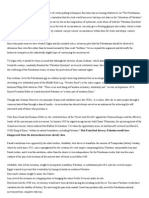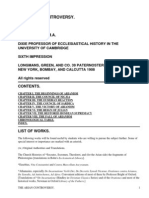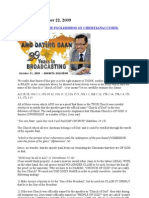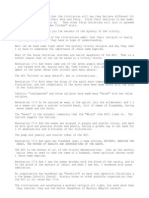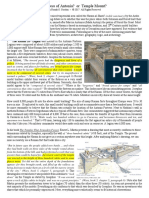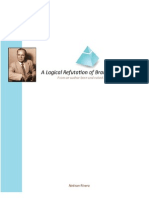0 ratings0% found this document useful (0 votes)
54 viewsFUNDAMENTALISM
FUNDAMENTALISM
Uploaded by
cindy dizonThe passage discusses the origins and development of fundamentalism within American Christianity in the late 19th and early 20th centuries. It began as a reaction against modernist theology, asserting traditional biblical standards. Fundamentalism was influenced by dispensational theology and ideas about the imminent second coming of Christ. The Niagara Conference in 1890 adopted a 14-point creed emphasizing biblical inerrancy, premillennialism, and conservative Reformed theology. This creed highlighted five essential fundamentals of the Christian faith that became central to the fundamentalist-modernist controversy of the 1920s. Fundamentalism grew through Bible institutes and publications like The Fundamentals, but eventually split between more separatist and more positive,
Copyright:
© All Rights Reserved
Available Formats
Download as DOCX, PDF, TXT or read online from Scribd
FUNDAMENTALISM
FUNDAMENTALISM
Uploaded by
cindy dizon0 ratings0% found this document useful (0 votes)
54 views6 pagesThe passage discusses the origins and development of fundamentalism within American Christianity in the late 19th and early 20th centuries. It began as a reaction against modernist theology, asserting traditional biblical standards. Fundamentalism was influenced by dispensational theology and ideas about the imminent second coming of Christ. The Niagara Conference in 1890 adopted a 14-point creed emphasizing biblical inerrancy, premillennialism, and conservative Reformed theology. This creed highlighted five essential fundamentals of the Christian faith that became central to the fundamentalist-modernist controversy of the 1920s. Fundamentalism grew through Bible institutes and publications like The Fundamentals, but eventually split between more separatist and more positive,
Original Description:
fundamentals
Copyright
© © All Rights Reserved
Available Formats
DOCX, PDF, TXT or read online from Scribd
Share this document
Did you find this document useful?
Is this content inappropriate?
The passage discusses the origins and development of fundamentalism within American Christianity in the late 19th and early 20th centuries. It began as a reaction against modernist theology, asserting traditional biblical standards. Fundamentalism was influenced by dispensational theology and ideas about the imminent second coming of Christ. The Niagara Conference in 1890 adopted a 14-point creed emphasizing biblical inerrancy, premillennialism, and conservative Reformed theology. This creed highlighted five essential fundamentals of the Christian faith that became central to the fundamentalist-modernist controversy of the 1920s. Fundamentalism grew through Bible institutes and publications like The Fundamentals, but eventually split between more separatist and more positive,
Copyright:
© All Rights Reserved
Available Formats
Download as DOCX, PDF, TXT or read online from Scribd
Download as docx, pdf, or txt
0 ratings0% found this document useful (0 votes)
54 views6 pagesFUNDAMENTALISM
FUNDAMENTALISM
Uploaded by
cindy dizonThe passage discusses the origins and development of fundamentalism within American Christianity in the late 19th and early 20th centuries. It began as a reaction against modernist theology, asserting traditional biblical standards. Fundamentalism was influenced by dispensational theology and ideas about the imminent second coming of Christ. The Niagara Conference in 1890 adopted a 14-point creed emphasizing biblical inerrancy, premillennialism, and conservative Reformed theology. This creed highlighted five essential fundamentals of the Christian faith that became central to the fundamentalist-modernist controversy of the 1920s. Fundamentalism grew through Bible institutes and publications like The Fundamentals, but eventually split between more separatist and more positive,
Copyright:
© All Rights Reserved
Available Formats
Download as DOCX, PDF, TXT or read online from Scribd
Download as docx, pdf, or txt
You are on page 1of 6
FUNDAMENTALISM
The arrival of fundamentalism as a movement within American
Christianity is usually dated from 1910 and the publication of a series of
booklets entitled The Fundamentals: A Testimony of Truth. The
booklets, printed by two wealthy Presbyterians, Los Angeles oilmen
Lyman Stewart (1840–1923) and Milton Stewart (1838–1923), were
distributed freely and were the textbooks for what in the 1920s became
the fundamentalist-modernist controversy. Fundamentalism so defined
is usually viewed as a reaction to modernism, asserting traditional
standards against the new theology and its search for scientific
compatibility. While there is much truth in that definition, it is limited. It
misses the essentially affirmative nature of fundamentalism and the
century-old movement, of which early twentieth-century
fundamentalism is but one passing phase.
Fundamentalism was, in its best form, an affirmative assertion of
certain ideas concerning Bible truth. At its beginning, it was a discovery
by clergy and laymen of American Protestant churches of the
dispensational theology of John Nelson Darby, discussed early in this
chapter. Conservative and evangelical, fundamentalism became a
rallying point for church leaders and, during the late nineteenth century,
was one of the major thrusts of Christianity in America.
In the mid-nineteenth century, the ideas of William Miller (1782–1849)
brought to public consciousness the doctrine of the Second Coming of
Christ and the dispensational theology of Darby, with its emphasis upon
the premillennial literal return of Jesus. In America, Darby found that
people accepted his ideas without leaving their own church to join the
Brethren. Outstanding Christian leaders became vocal exponents of
dispensational theology. Possibly none was as effective as evangelist
Dwight L. Moody, who had been deeply affected by Brethren evangelist
Henry Moorhouse Leading ministers—Adoniram J. Gordon, Arthur T.
Pierson (1837– 1911), William G. Moorehead (1836–1914), and James
H. Brooks—were all changed by Brethren thinking.
In 1869 a group of ministers associated with a millennial
periodical, Waymarks in the Wilderness, held the first of what became
the Believers Meeting for Bible Study. The ministers met to promote
belief in the “doctrine of the verbal inspiration of the Bible, the
personality of the Holy Spirit, the atonement of (Christ’s) sacrifice, the
priesthood of Christ, the two natures in the believer, and the personal
imminent return of our Lord from heaven.” In 1883 the annual meetings
were moved to Niagara-on-the-Lake, Ontario, and thus became known
as the Niagara Conference on Prophecy.
Part of the aim of the Niagara Conference was to manifest the primitive
idea of the ecclesia, the church. Thus the conference was the ministers’
means of forming what Darby called the church, a gathering of
believers free of denominational systems. However, the ministers did
not leave their mainline denominations. They gathered for the informal
closeness and doctrinal purity that Darby said should characterize the
church. They used the Bible reading as developed by the Brethren, and
they accepted Darby’s ideas on dispensationalism and his eschatology.
In 1890 a definitive step for the whole course of fundamentalism
occurred. The Niagara Conference adopted a “creedal statement.” The
14-point statement was highly determinative of the movement’s future
course and set its priorities. The premillennial return of Christ is
asserted as the answer to the impossibility of converting the world in
this dispensation. The conference accepted the premillennialists’ idea
that the world is becoming less Christian, with evolution not bringing
real human progress, thus necessitating Christ’s direct intervention
before the millennium. The conference was dominated by a mixture of
Darby’s ideas (especially on eschatology) and what is termed Princeton
theology, a conservative Reformed theology developed at Princeton
Theological Seminary. Princeton theology had developed new
language to assert the authority of the Bible in the face of challenges by
Darwinism, new historical critical approaches to the Bible, and liberal
theology. It affirmed that the Bible (in its original text) was inerrant; that
all scriptures, including the books of the Jewish Bible (the Old
Testament), were Christ-centered; and that all of the books of the Bible
are equally inspired.
The Niagara statement also included the Reformed theological
emphasis on human depravity and salvation by the blood of Christ,
which were assertively detailed in six articles. Almost all of the
attendees at the Niagara Conference were from churches of the
Reformed heritage, and it is not surprising that support for the Niagara
statement drew most of its response from churches of the Reformed
heritage (Baptist, Presbyterian, Reformed, and Congregational). In the
1920s, fundamentalism had its major battleground in the Baptist and
Presbyterian churches.
Fundamentalists also cut off other conservative Christians who might
have offered some support. For example, they denied the second
blessing (a major idea of the Holiness movement—the second blessing
is a personal religious experience after which the believer is thought to
be perfected for life), and two ideas of the Adventists—soul-sleep and
annihilationism. Soul-sleep is the idea that the soul exists in an
unconscious state from the individual’s death until the general
resurrection of the body. Annihilationism is the belief that the wicked
cease to exist, instead of existing in torment in hell for eternity. While
some Methodists and some Adventists would, in the 1920s, agree on
the five fundamentals, the Methodists and Adventists were not
prominent in the fundamentalist movement.
From the 14-point Niagara statement, five points were lifted up as the
most essential, the very fundamental beliefs of anyone who could be
considered a Christian. The five fundamentals, as they came to be
known, are: (1) the inspiration and infallibility of the Bible; (2) the deity
of Christ (including his virgin birth); (3) the substitutionary atonement
accomplished in Christ’s death; (4) the literal resurrection of Christ from
the dead; and (5) the literal return of Christ in the second advent. These
points assume the truth of the ecumenical creeds, the Nicene and
Chalcedonian. At the height of the modernist-fundamentalist
controversy in the 1920s, the five fundamentals would become the
crucial points around which arguments were focused.
The group consciousness of the leaders of the Niagara Conference
was solidified in the several Bible institutes that were founded in the
late nineteenth century. The most influential of these was the Moody
Bible Institute in Chicago, but others, including the Bible Institute of Los
Angeles, Philadelphia Bible Institute, the Toronto Bible Training School,
and the Northwestern Bible Training School in Minneapolis, contributed
to the cause. These schools institutionalized fundamentalism and, more
importantly, helped train its future leaders.
In the early years of the twentieth century, the most prominent of the
fundamentalist leaders was Arno E. Gaebelein (1861–1945), a former
Methodist who left that church after accepting dispensational theology.
He began a magazine, Our Hope, in 1899. He also helped finance the
work on the Scofield Reference Bible, the single most influential source
of Darby’s theology in the modern era.
New life flowed into the movement with the publication of The
Fundamentals in 1910, and Darbyite fundamentalism came into direct
conflict with emerging liberalism in the decade before World War
I (1914–1918). The Fundamentals followed the lead of the Niagara
Creed in asserting the verbal inerrancy of scripture, the Calvinist
doctrine of human depravity, and the imminent Second Coming. As
modernist thinking grew, polemics led to polarization within American
Protestantism, and polarization was followed by the formation of new
denominations. The modernist thinking was highlighted by a theology
that accepted the theory of evolution, and by higher biblical criticism,
the study of the Bible in the light of the findings of secular historians
and archeologists.
The new denominations occasioned by the fundamentalist controversy
were of two kinds. First, from the several large Protestant bodies arose
fundamentalist churches that differed only from their parent bodies by
acceptance of a fundamentalist mind-set with which to interpret the
parent bodies’ own doctrinal statements (such as the General
Association of Regular Baptist Churches). Second, there emerged new
religious bodies that encompassed the total fundamentalist thrust and
were the truly American form of the Plymouth Brethren tradition
discussed earlier in this chapter. These have been referred to as
the undenominated churches, since they were organized in loose
fellowships. They had a dispensational theology with the Reformed
emphasis of Niagara, and became the ecclesiastical products of the
Bible institutes (such as the Independent Fundamental Churches of
America).
Fundamentalism of both kinds split into essentially two parties. One
group emphasizes separation from all apostasy and from particular
forms of evil, such as communism, the National Council of Churches,
and organizations that compromise the faith. It also separated from its
former colleagues who chose to remain in the larger liberal
denominations.
A second group also emerged among those who left the denominations
but wanted to retain a relationship with colleagues who for various
reasons wished to stay in their post. This group developed a more
positive attitude toward the world and articulated a desire to engage
modern intellectual thought and culture while retaining an allegiance to
a conservative theological stance. Neo-Evangelicalism (or today just
Evangelicalism) is the name assumed by this postfundamentalist
movement. Its leaders have tried to be honest with natural science,
conversant on philosophy and theology, and socially concerned.
The separatists have been associated with the American Council of
Christian Churches (ACCC) and the ministry of Dr. Carl McIntire (1906–
2002), whose organ of expression was for many years the Christian
Beacon. McIntire founded and headed the Bible Presbyterian Church.
Membership in the ACCC is made up largely of small separatist bodies.
The more inclusive approach is advocated by the National Association
of Evangelicals (NAE). It includes a wide range of bodies that accept its
minimal statement of faith. The NAE accepts not only church bodies,
but also conferences and local churches, or groups not otherwise
affiliated. The independent magazine, Christianity Today, is the most
important periodical of neo-Evangelicalism, though the NAE has its own
organ, United Evangelical Action.
In the last quarter of the twentieth century, Evangelicals and
fundamentalists made common cause on the political front in the United
States with the formation of a conservative movement espousing the
goal of enacting into law some of their moral ideals, especially as they
relate to sexual morality. Motivation for the rise of what has been
termed the Christian Right was the 1973 Supreme Court case Row v.
Wade, which was widely perceived as legalizing abortion. The same
decade saw the rise of the homosexual rights movement. Conservative
Christian leaders saw these two issues tied together by the larger issue
of widespread disregard of traditional sexual ethics and open support
for sexual activity outside of the bounds of heterosexual marriage.
The Christian Right movement also grew upon the success of religious
broadcasting, the Evangelicals having come to dominate Christian-
based radio and television. Many of the leaders of the Christina Right
had originally gained a level of fame and public support through their
radio and television shows, most notably Jerry Falwell (1933–
2007), Pat Robertson (b. 1930), Tim Lahaye (b. 1926) and Beverly
Lahaye (b. 1930), and James Dobson (b. 1936). During the
administration (1981–1989) of President Ronald Reagan (1911–2004),
the Christian Right aligned with the Republican Party, within which it
attained a powerful presence. Though unable to push much legislation
through Congress or overturn Roe v. Wade, the Christian Right was
able to block a variety of legislative initiatives, and during the George
W. Bush administration (2001–2009) attained a few of its goals (such
as the funding of faith-based charity work) through presidential fiat.
Meanwhile, the movement proved unable to stop the slow but steady
establishment in law of gay and lesbian rights.
You might also like
- M. David Litwa - The Evil Creator - Origins of An Early Christian Idea-Oxford University Press (2021)Document225 pagesM. David Litwa - The Evil Creator - Origins of An Early Christian Idea-Oxford University Press (2021)Ars Umbris100% (2)
- Book of ST CyprianDocument82 pagesBook of ST CyprianJay Servito80% (10)
- (Creflo Dollar) Walking in The Confidence of GodDocument96 pages(Creflo Dollar) Walking in The Confidence of Godsamuel100% (1)
- Facts of Faith by Christian Edwardson PDFDocument2 pagesFacts of Faith by Christian Edwardson PDFJaidaNo ratings yet
- Fatal Flaws in 2house Theory Rabbi Greg HershbergDocument11 pagesFatal Flaws in 2house Theory Rabbi Greg HershbergGabriel R.No ratings yet
- Allies For Armageddon - The Rise of Christian ZionismDocument342 pagesAllies For Armageddon - The Rise of Christian ZionismAndré Daniel ReinkeNo ratings yet
- The Ark of The Covenant in Its EgyptianDocument9 pagesThe Ark of The Covenant in Its EgyptianCarlos Alexandre CostaNo ratings yet
- One Jesus and Four Primitive GospelsDocument46 pagesOne Jesus and Four Primitive Gospelslauraosigwe11No ratings yet
- How The Conversion of Rus' Was Understood in The Eleventh CenturyDocument17 pagesHow The Conversion of Rus' Was Understood in The Eleventh CenturyFathy Abdul AzizNo ratings yet
- The New Testament Is The Second Half of The Christian BibleDocument5 pagesThe New Testament Is The Second Half of The Christian BibleKnicks LoganNo ratings yet
- The Blood of The Lamb - The Story of A Religious CoupDocument7 pagesThe Blood of The Lamb - The Story of A Religious CoupAwarenessSpotNo ratings yet
- 06 Lost GospelsDocument2 pages06 Lost Gospelsdavevan2010No ratings yet
- Why Haven't The Aliens Invaded AlreadyDocument3 pagesWhy Haven't The Aliens Invaded AlreadybasharfanNo ratings yet
- 1 Covenant PeopleDocument8 pages1 Covenant PeopleWilliam .williamsNo ratings yet
- Coptic Christians: An Inquiry Into Their Contemporary Status in EgyptDocument29 pagesCoptic Christians: An Inquiry Into Their Contemporary Status in EgyptKundan KumarNo ratings yet
- 23509012Document37 pages23509012I JewNo ratings yet
- When Were Our Gospels Written - An Argument, Tischendorf, Constantin Von. (1867)Document124 pagesWhen Were Our Gospels Written - An Argument, Tischendorf, Constantin Von. (1867)David Bailey100% (1)
- Arab-Palestinian Relations E.karshDocument4 pagesArab-Palestinian Relations E.karshsamuelfeldbergNo ratings yet
- Authority of Gospels JWDocument4 pagesAuthority of Gospels JWKomishinNo ratings yet
- Restoration ReadingsDocument6 pagesRestoration ReadingsDavid JiménezNo ratings yet
- The Arian Controversy by Gwatkin, Henry Melvill, 1844-1916Document84 pagesThe Arian Controversy by Gwatkin, Henry Melvill, 1844-1916Gutenberg.orgNo ratings yet
- Because God Had Taken Him"Document15 pagesBecause God Had Taken Him"wrexqtwNo ratings yet
- Bjig 04 Lord To My Lord Ps 110 1 6 1 15Document12 pagesBjig 04 Lord To My Lord Ps 110 1 6 1 15api-232389092100% (1)
- The Syro-Ephraimite War - Context Conflict and ConsequencesDocument15 pagesThe Syro-Ephraimite War - Context Conflict and ConsequencesFda100% (1)
- Daniel Sarlo Was There Zoroastrian Influence On The JDocument27 pagesDaniel Sarlo Was There Zoroastrian Influence On The Jscribdupl-papers.ibrahim451No ratings yet
- The Most Important Biblical Discovery of Our TimeDocument21 pagesThe Most Important Biblical Discovery of Our Timececampillo100% (1)
- Did William Tyndale Celebrate Christmas?Document4 pagesDid William Tyndale Celebrate Christmas?R. Magnusson DavisNo ratings yet
- Grabbe, What Was Ezra's MissionDocument14 pagesGrabbe, What Was Ezra's Mission류의근No ratings yet
- Fruchtenbaum ReplacementTheologyaDocument32 pagesFruchtenbaum ReplacementTheologyaHelio F PNo ratings yet
- Catholic Kath'HolesDocument39 pagesCatholic Kath'HolesElacam OetamNo ratings yet
- The MYSTERY of The Trinity RevealedDocument2 pagesThe MYSTERY of The Trinity RevealedBroSteveWinter100% (1)
- Curse of CainDocument3 pagesCurse of CainSSJ7No ratings yet
- Writing The Pentecostal History of Africa, Asia and Latin AmericaDocument15 pagesWriting The Pentecostal History of Africa, Asia and Latin AmericaIan David MartinNo ratings yet
- 7 FestivalsDocument2 pages7 FestivalsDurai RajNo ratings yet
- Sabbath and GenesisDocument8 pagesSabbath and GenesisJared Nun Barrenechea BacaNo ratings yet
- Pfof1950 V01 PDFDocument1,006 pagesPfof1950 V01 PDFFilep-LukácsIstvánNo ratings yet
- The Byzantine EmpireDocument25 pagesThe Byzantine EmpirekjrazoNo ratings yet
- The Living God - Edmond Jacob - Theology of The Old TestamentDocument7 pagesThe Living God - Edmond Jacob - Theology of The Old TestamentBogdan SoptereanNo ratings yet
- FaithOnTrial by Robert WielandDocument177 pagesFaithOnTrial by Robert Wielandombogonoah8No ratings yet
- Ignatius of AntiochDocument5 pagesIgnatius of AntiochRene SarmientoNo ratings yet
- Legion Was Housed in The Antonia Fortress.: by Ronald J. Gordon © 2017 All Rights ReservedDocument4 pagesLegion Was Housed in The Antonia Fortress.: by Ronald J. Gordon © 2017 All Rights Reservedmordy180% (1)
- 1999 Issue 6 - A Critique of Steven Schlissel's Articles Against The Regulative Principle of Worship - Counsel of ChalcedonDocument18 pages1999 Issue 6 - A Critique of Steven Schlissel's Articles Against The Regulative Principle of Worship - Counsel of ChalcedonChalcedon Presbyterian ChurchNo ratings yet
- Eusebius Pamphylus Church HistoryDocument195 pagesEusebius Pamphylus Church HistoryMike AlexNo ratings yet
- 2009 ChaferConf Fruchtenbaum Paper - MIDRASH PESHER AND HERMENEUTICS PDFDocument45 pages2009 ChaferConf Fruchtenbaum Paper - MIDRASH PESHER AND HERMENEUTICS PDFDodongValdezNo ratings yet
- Genesis 6 Commentary - Arno Gaebelein's Annotated BibleDocument2 pagesGenesis 6 Commentary - Arno Gaebelein's Annotated BibleFather BrownNo ratings yet
- 4 - The MaccabeesDocument2 pages4 - The Maccabeesacer smithNo ratings yet
- Inaugurated EschatologyDocument2 pagesInaugurated EschatologyTimothy BertoletNo ratings yet
- The Concept of God in Deutero IsaiahDocument14 pagesThe Concept of God in Deutero IsaiahDavide VarchettaNo ratings yet
- First Christians Believed in Henotheism A God-Eat-God Cosmic SystemDocument10 pagesFirst Christians Believed in Henotheism A God-Eat-God Cosmic Systembasharfan100% (1)
- Christ in CornwallDocument33 pagesChrist in CornwalllymanowenNo ratings yet
- Bible Slides 1-85 210623Document85 pagesBible Slides 1-85 210623Anakdani PunyathasupNo ratings yet
- Mbs 063 MDocument18 pagesMbs 063 MjallahhiamaNo ratings yet
- Eustace Mullins New World Order PDFDocument2 pagesEustace Mullins New World Order PDFAmit0% (1)
- Islam - Muslims Notes World HistoryDocument6 pagesIslam - Muslims Notes World Historykolbe1walshNo ratings yet
- Articles On EschatologyDocument291 pagesArticles On EschatologygeorgetacaprarescuNo ratings yet
- Unseeing The Shown, Showing The Unseen, Guffey Andrew 2014Document316 pagesUnseeing The Shown, Showing The Unseen, Guffey Andrew 2014Adrián BetNo ratings yet
- Persecution On JewsDocument2 pagesPersecution On Jewshowe338No ratings yet
- Bible-A Tale of TranslationsDocument3 pagesBible-A Tale of TranslationsTravis WoodNo ratings yet
- Basilides's Gospel and Exegetica (Treatises) : Vigiliae Christianae June 2005Document22 pagesBasilides's Gospel and Exegetica (Treatises) : Vigiliae Christianae June 2005Jamal DookhyNo ratings yet
- The Jesuits Their History Constitution Moral Teaching Political Principles Religion and Science by Otto HenneDocument92 pagesThe Jesuits Their History Constitution Moral Teaching Political Principles Religion and Science by Otto HennevjencoNo ratings yet
- The Lake of Fire in Revelation 19 and 20Document6 pagesThe Lake of Fire in Revelation 19 and 20Jensen RuudNo ratings yet
- Certificate Design-Recognition - 20240528 - 142458 - 0000Document5 pagesCertificate Design-Recognition - 20240528 - 142458 - 0000cindy dizonNo ratings yet
- English4 Q1 Week1 PPT MATATAGDocument116 pagesEnglish4 Q1 Week1 PPT MATATAGcindy dizonNo ratings yet
- July 31,2024-Q1-DLLDocument4 pagesJuly 31,2024-Q1-DLLcindy dizonNo ratings yet
- April 1, 2024Document3 pagesApril 1, 2024cindy dizonNo ratings yet
- English4 Q1 Week1 PPT MATATAGDocument110 pagesEnglish4 Q1 Week1 PPT MATATAGcindy dizonNo ratings yet
- New Class ProgramDocument4 pagesNew Class Programcindy dizonNo ratings yet
- April 22, 2024Document3 pagesApril 22, 2024cindy dizonNo ratings yet
- ENGLISH-5-10Most&Least Learned CompetenciesDocument1 pageENGLISH-5-10Most&Least Learned Competenciescindy dizonNo ratings yet
- Lesson PlanDocument4 pagesLesson Plancindy dizonNo ratings yet
- November 8, 2022Document8 pagesNovember 8, 2022cindy dizonNo ratings yet
- Assignment in Curr - DevDocument1 pageAssignment in Curr - Devcindy dizonNo ratings yet
- September 4, 2023Document3 pagesSeptember 4, 2023cindy dizonNo ratings yet
- November 7, 2022Document1 pageNovember 7, 2022cindy dizonNo ratings yet
- November 3-4, 2022Document1 pageNovember 3-4, 2022cindy dizonNo ratings yet
- December 1, 2022Document7 pagesDecember 1, 2022cindy dizonNo ratings yet
- English Most Least MasteredDocument1 pageEnglish Most Least Masteredcindy dizonNo ratings yet
- The Complete Netbook of Witches & Warlocks Supplement I Eldritch Witchery (2e)Document64 pagesThe Complete Netbook of Witches & Warlocks Supplement I Eldritch Witchery (2e)tadao.ando100% (1)
- C Destiny 12 180 Pages (001 180)Document180 pagesC Destiny 12 180 Pages (001 180)inaahillabianoNo ratings yet
- Giussani Luigi Comments On Miguel MañaraDocument16 pagesGiussani Luigi Comments On Miguel Mañarabenitoupegui26498100% (1)
- 10.4.1 God Created in People A Concern For JusticeDocument8 pages10.4.1 God Created in People A Concern For Justicesherylmatchado07No ratings yet
- The SDA Evangelical Conferences 1955-1956 (TE Unruh)Document12 pagesThe SDA Evangelical Conferences 1955-1956 (TE Unruh)Willem H. van der PlasNo ratings yet
- (English (Auto-Generated) ) ST Rose of Viterbo & The Anti Christ (DownSub - Com)Document12 pages(English (Auto-Generated) ) ST Rose of Viterbo & The Anti Christ (DownSub - Com)eekdswNo ratings yet
- Bible Training Centre For Pastors+3+SampleDocument7 pagesBible Training Centre For Pastors+3+SampleTransforming communities Uganda100% (1)
- Peruvian North American Abraham Lincoln School: Humanities - Religion First Term - 2021 Baha'I Faith Paper 1Document2 pagesPeruvian North American Abraham Lincoln School: Humanities - Religion First Term - 2021 Baha'I Faith Paper 1ErickHenryNo ratings yet
- Essay 15 - FestivalsDocument2 pagesEssay 15 - Festivalsqbich37No ratings yet
- The Birth of JesusDocument2 pagesThe Birth of Jesusemma “Charly” lambNo ratings yet
- A Logical Refutation of Branham's MessageDocument106 pagesA Logical Refutation of Branham's MessageEric PementNo ratings yet
- The Atonement Between God and Man (Studies in The Scriptures) by Charles T. RussellDocument409 pagesThe Atonement Between God and Man (Studies in The Scriptures) by Charles T. RussellPrayitnoNo ratings yet
- Mad Girl's Love SongDocument1 pageMad Girl's Love Songlhyla86No ratings yet
- Ignatian Theme: Spiritual Freedom: Morning Praise - Day 5Document3 pagesIgnatian Theme: Spiritual Freedom: Morning Praise - Day 5Pranciss Duya100% (1)
- Forum Doktoranckie - E.Nyske - UAMDocument15 pagesForum Doktoranckie - E.Nyske - UAMEwelina BerdowiczNo ratings yet
- To The ParticipantsDocument1 pageTo The ParticipantsAj Marielle PongcolNo ratings yet
- Christianity and ZoroastrianismDocument11 pagesChristianity and Zoroastrianismabhinav0% (1)
- The Murder at The Vicarage - Agatha ChristieDocument142 pagesThe Murder at The Vicarage - Agatha ChristieEnacb Scb100% (1)
- Mark Book of Week - Part 1Document33 pagesMark Book of Week - Part 1api-264767612No ratings yet
- Bulletin - January 29, 2023Document4 pagesBulletin - January 29, 2023sthelenscatholicNo ratings yet
- Saint Mary's, Saint Michael's, and Ss John & Ailbe 10 July 2022: The Fourth Sunday After Trinity (Proper 10)Document4 pagesSaint Mary's, Saint Michael's, and Ss John & Ailbe 10 July 2022: The Fourth Sunday After Trinity (Proper 10)Niall James SloaneNo ratings yet
- Noli Me TangereDocument20 pagesNoli Me TangereLiza Y. Espinosa100% (1)
- Thesis Chapter 1-5Document89 pagesThesis Chapter 1-5JM VillarubiaNo ratings yet
- Making Windows in HeavenDocument4 pagesMaking Windows in Heavenmercymeda08No ratings yet
- Content and Contextual Analysis of (Travelogue) Antonio Pigafetta's First Voyage Around The World1Document4 pagesContent and Contextual Analysis of (Travelogue) Antonio Pigafetta's First Voyage Around The World1Florante AgnoNo ratings yet
- AQA Religious Studies B. Catholic Christianity. 1. Creation: Key Words Key QuotesDocument10 pagesAQA Religious Studies B. Catholic Christianity. 1. Creation: Key Words Key QuotesHarry AlexNo ratings yet
- PolishDocument56 pagesPolishNorwelle Altamarino BaluyanNo ratings yet

















